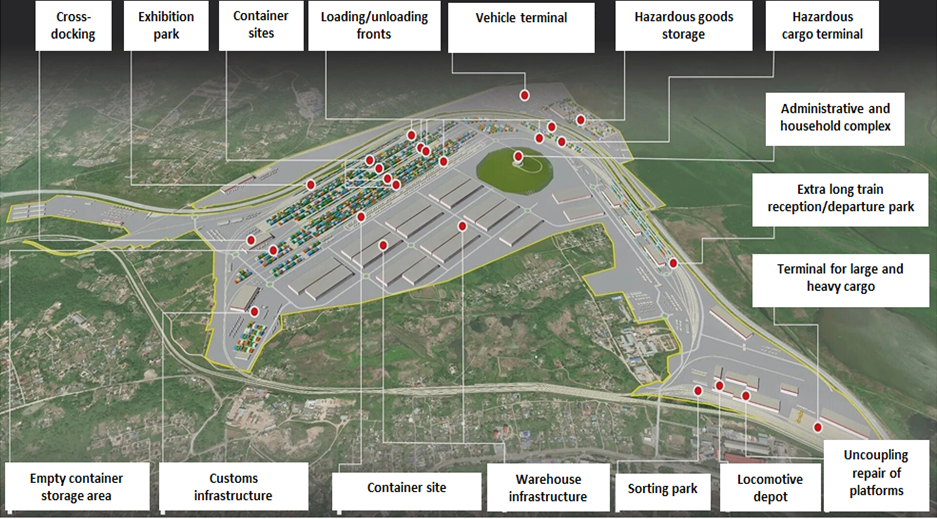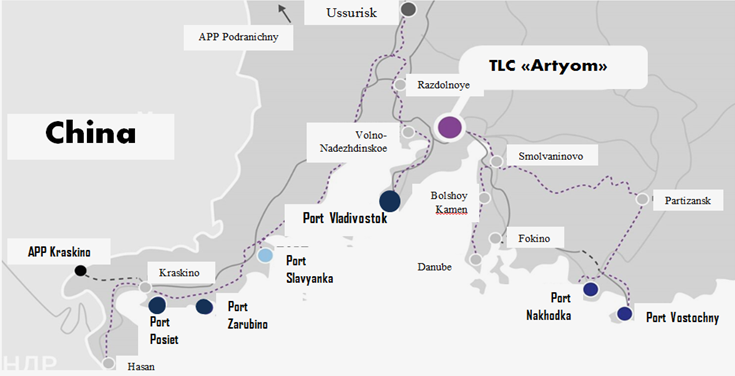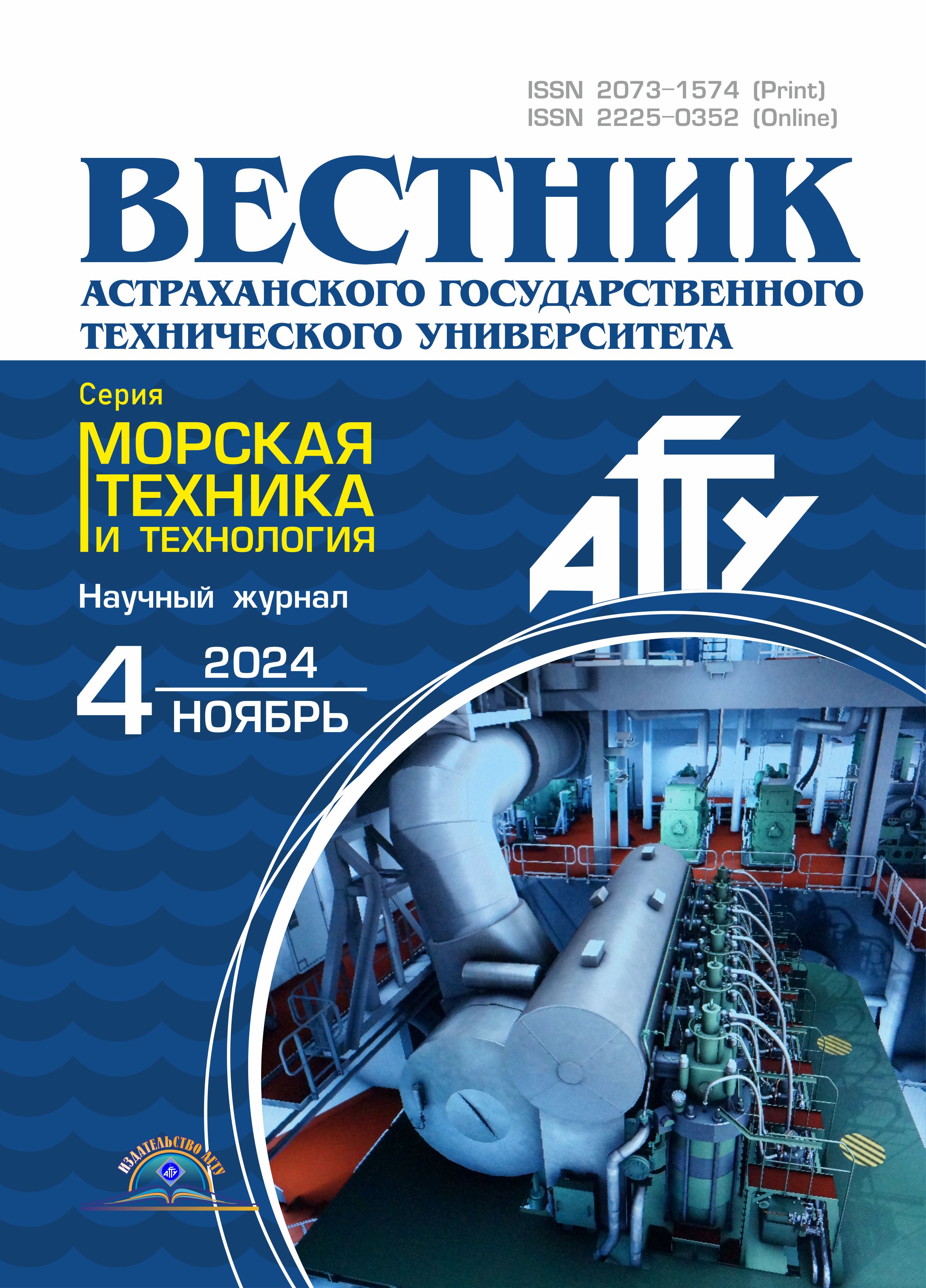Russian Federation
Russian Federation
The development of international trade is directly linked to seaports and contributes to the economic growth of the regions where they are located. With the growth of trade turnover, it is ports that become logistics centers for cargo transportation, as well as a point of concentration of production and related services, which increases the attractiveness of regions for investment. But there is another side to this phenomenon – the congestion of terminals with cargo. Due to the modern conditions of globalization of transport processes, there is a need to revise approaches and more rational planning of logistics infrastructure activities both in Russia and in other countries. An important issue is the maintenance of the transport and logistics infrastructure against the background of an ever-growing volume of traffic. At the same time, cargo flows annually change their direction, range, become busier, etc. There is a way out of the current problem in global logistics with the congestion of seaports – this is the construction of a specialized terminal that does not require direct sea access, providing services for the storage, transportation and processing of goods – “dry port”. It is stated that the ability of seaports to process cargo will increase, and reconstruction costs will be minimal. Such ports can be an effective solution for countries that are landlocked or have sufficient maritime space. They allow you to save resources (finances, time) by transporting goods directly from the internal regions of the country to the world market. The prospects for the construction and development of the “dry port” as an object of the transport and logistics infrastructure of the Far East are discussed.
“dry port”, containers, terminal, transportation, cargo flows, railway
Introduction
Currently, the ports of the Far East are faced with a situation very similar to the one that was just two years ago – the terminals are again filled with loaded containers, and the delivery time from China to the western regions of Russia via Vladivostok, according to representatives of the logistics market, has increased by three weeks. This, in turn, leads to a violation of previously concluded contracts, which entails the payment of fines and, accordingly, leads to financial losses.
Due to the lack of trade relations with many European countries, China remains one of Russia's largest trading partners. The territorial proximity of the Far East also contributes to this. Enterprises, companies and organizations that previously specialized in European cargoes are now changing their direction towards eastern countries, including China [1]. This state of affairs contributed to the fact that the number of imported containers increased, while exported ones, on the contrary, decreased. In order to maintain the stability and increase the efficiency of the logistics chain, according to experts, operational system solutions are needed. One of such solutions is the construction of a “dry port” [2]. This concept is not legally fixed in documents, but experts in the field of transport and logistics operations use this term most often.
Research materials
The main difference between a sea port and a dry port is that a dry port does not have the ability to receive ships and is most often built far from the coast.
Cargo delivery is carried out according to the following scheme:
1) cargo is transported by sea on a ship to the port of destination;
2) after the ship has docked, the cargo is reloaded to the warehouse site in the port (in the case of containers);
3) next, the car transports the cargo from the warehouse of the port to the “dry port”;
4) the dry port organizes cargo transshipment from the vehicle to the railway platform and then the cargo is sent to the destination (Fig.1).

Fig. 1. The scheme of cargo transportation through the “dry” container terminal
The production complex, having its own railway access roads, allows you to accumulate container cargoes for the formation and further dispatch of accelerated container trains without occupying the infrastructure of the seaport.
“Dry ports” are located outside urban areas, which significantly increases their logistical attractiveness, allowing cargo to be received and exported in all directions by rail, road and air transport. Due to the need to enter urban traffic, the recipients' time is reduced and the efficiency of delivery is increased.
To date, several “dry ports” operate on the territory of Primorsky Krai, such as:
1. Sukhoi Port LLC (Artyom, Uglovoye settlement), specializing in the processing of various types of cargo, including large-capacity refrigerated containers, dry containers and general cargo.
2. Astafiev Terminal JSC (Nakhodka), with a capacity of 5 000 TEU and 2.5 km of open areas railway infrastructure.
3. The multifunctional logistics complex (transport and logistics complex) Union TLC, which includes a class. A warehouse complex with a total area of 30 000 m2 and a railway container terminal capable of processing about 1 million tons of cargo per year (located in close proximity to the federal highway M60 “Vladivostok – Khabarovsk”).
4. Dry terminals of Pacific Intermodal Container JSC (PIC JSC), Fresh Terminal (Ugolnaya station) and Khlebnaya Baza Terminal (Ussuriysk), which are part of the VSCT (Vladivostok Sea Container Terminal) LLC complex specializing in the transshipment of containerized cargoes of coastal and export-import lines [1, 2].
The development of containerization of cargo flows, including regime cargo, as a replacement for refrigerated transport is possible only in the port-port directions, which in turn significantly increases the load on port facilities and requires the creation of new “dry ports” for further shipment of refrigerated containers to western regions [3].
Results of the study
Currently, it is planned to build a transport and logistics center (Artyom TLC) with an area of 455.0 hectares on the territory of Primorsky Krai (Artyom), which will be the largest “dry port” on the territory of not only the Far East, but also the country as a whole [4, 5].
Artyom TLC will be connected to two adjacent stations at once: Artyom 1 and Artyom-Primorskiy 2. On the territory of the Sukhoi port, it is planned to build a depot for locomotives that will enter and leave from one terminal, which will create conditions for passing trains (i.e. ring technology) and will allow efficient use of the resources of Russian railways roads. Artyom TLC also provides warehouse, terminal and customs infrastructure. According to forecasts of experts in the field of logistics, the port will be able to carry out more than 50 container shipments daily, as well as handle up to 1 million. containers per year [6]. Cargo transshipment will be carried out according to the wagon-car option and sent to the regions of Siberia, the Urals and the European part of Russia (Fig. 2).

Fig. 2. The general plan for the construction of Artyom TLC [4]
Artyom TLC will be included in a multimodal network consisting of 11 “dry ports” located in different regions throughout Russia. As for seaports, especially in Primorsky Krai, their terminals will increase their work by 1.5 times, but most importantly − the creation of more than 10 000 jobs in related areas [1].
The port's specialization will be aimed at processing domestic and export-import cargo flows. Since analysts working in the field of logistics predict an increase in cargo transshipment volumes in the Far Eastern direction every year, against the background of the reorientation of trade relations from West to East, Artyom TLC will contribute to improving the efficiency of the ports of the Far East (Fig. 3).

Fig. 3. Location of “dry port” in Artyom and its transport accessibility
The creation of a “dry port” in Artyom will allow solving problems with import-export container transportation, which have been arising more and more often in the last few years due to the prevailing restrictions in the conditions of the infrastructure of seaports. For example, the introduction of technology for loading containers into gondola cars will speed up the processing of container trains and free up gondola cars that were previously used to transport coal.
The technological model of the terminal provides for the processing of extended-length trains and container trains with gondola cars − all this in order to increase cargo flows in limited areas, as well as speed up the delivery of goods/goods, both for industry and for the population of Primorsky Krai [6].
Artyom TLC construction project is aimed at developing the transport infrastructure of the urban agglomeration, unloading container terminals of the ports of Primorsky Krai.
The project for the construction of this port was approved and recognized as a priority by the Government of Primorsky Krai. Artyom TLC aims to process more than one million TEU (twenty-foot equivalent) per year. To date, there are no analogues of such a “dry port” in the Far East and generally in Russia [7].
It is expected that the launch of the transport and logistics center will optimize the operation of the ports of Vladivostok and Nakhodka, increase the capacity of the Trans-Siberian railway and, in general, will contribute to improving the competitiveness of the entire transport system of the Far East.
The first stage of the project for the implementation of the transport and logistics center includes the construction of a power plant, access roads, as well as the reconstruction of railway networks. The completion of the first stage is scheduled for 2025. The second stage should be implemented by the end of 2027. After its completion, the capacity of the high-tech complex will reach 1 million TEU per year. Artyom TLC will include: railway, warehouse, terminal and customs infrastructure.
Thanks to the construction of Artyom TLC, in the city Vladivostok, which is currently the center of international cooperation between Russian Federation and the countries of the Asia-Pacific region, will further increase its importance in the market, as the territories adjacent to the city are increasingly being included in the logistics complex of the capital of the Far East.
Conclusion
The development of logistics centers, as well as the redistribution of cargo flows, lead to a multiplier effect in the economy, i.e., along with the logistics sector, adjacent areas of the economy begin to develop (for example, road construction, trade, services and supply, energy and engineering infrastructure, etc.) [7, 8].
Currently, logistics in the Far East is actively developing and has great potential, especially for the transportation of Chinese goods.
The implementation of projects such as Artyom TLC is important for the development of the region's economy and its attractiveness for investment, as well as for strengthening the international image of the entire Far East as part of the Asia-Pacific region and an active participant in international economic cooperation.
In addition, the modernization of transport and logistics activities in the direction of the development of “dry ports” will help solve one of the main problems – the shortage of container warehouses and storage facilities in the ports of the region. Large logistics centers of the Asia-Pacific region, such as Shanghai, Busan, Guangzhou, etc., created similar distribution centers for container cargo traffic, freeing up the coastal and port infrastructure directly.
1. Mul'timodal'nyj effekt suhogo porta [Multimodal dry port effect]. Available at: https://transportrussia.ru/razdely/logistika/9785-multimodalnyj-effekt-sukhogo-porta.html?ysclid=m2ivssmnhx807124080 (accessed: 28.09.2024).
2. Val'kov V. E., Kovylin Yu. Yu. Problemy diversifikacii eksportnyh gruzopotokov na Vostok i puti ih resheniya [Problems of diversification of export cargo flows to the East and ways to solve them]. Transportnoe delo Rossii, 2023, no. 2, pp. 153-154.
3. Logisticheskij kollaps. Kontejnery uperlis' v propusknuyu sposobnost' zheleznoj dorogi [Logistical collapse. The containers rested against the railway's capacity]. Available at: https://konkurent.ru/article/69969 (accessed: 30.09.2024).
4. Transportno-logisticheskij centr Artem [Artyom Transport and Logistics Center]. Available at: https://tlc-artem.ru/?ysclid=m342mpd2k637430854 (accessed: 01.09.2024).
5. Suhie porty – klyuchevye ob"ekty infrastruktury mezhdunarodnogo znacheniya [Dry ports are key infrastructure facilities of international importance]. Available at: https://www.logistika-prim.ru/articles/suhie-porty-klyuchevye-obekty-infrastruktury-mezhdunarodnogo-znacheniya?ysclid=m2ivsathsw434671528 (accessed: 01.09.2024).
6. V Primorskom krae postroyat krupnejshij na Dal'nem Vostoke suhoj port na 1 mln kontejnerov v god dlya razvitiya perevozok s Kitaem [Primorsky Krai will build the largest dry port in the Far East with 1 million containers per year for the development of transportation with China]. Available at: https://www.rzd-partner.ru/logistics/news/v-primorskom-krae-postroyat-krupneyshiy-na-dalnem-vostoke-sukhoy-port-na-1-mln-konteynerov-v-god-dlya/ (accessed: 01.09.2024).
7. Galin A. V. Suhie porty kak chast' transportnoj infrastruktury. Napravleniya razvitiya [Dry ports as part of the transport infrastructure. Directions of development]. Vestnik Gosudarstvennogo universiteta morskogo i rechnogo flota imeni admirala S. O. Makarova, 2014, no. 2 (24), pp. 87-92.
8. Rahmangulov A. N., Murav'ev D. S. Razvitie morskoj portovoj infrastruktury regiona na osnove «suhih portov» [Development of the sea port infrastructure of the region on the basis of “dry ports”]. Ekonomika regiona, 2016, vol. 12, no. 3, pp. 924-936.

















